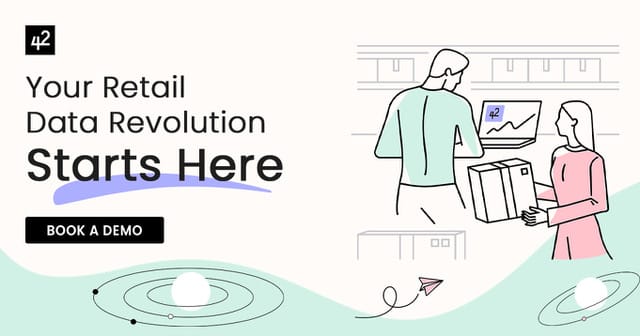Predictive Analytics in Retail: How to Give the Customers What They (Truly) Want
“A lot of times, people don’t know what they want until you show it to them.” - Steve Jobs

“A lot of times, people don’t know what they want until you show it to them.” - Steve Jobs
If you’ve been in retail for more than a season, you know how painfully true this statement is. While shoppers say they want XYZ, their actions often show their true desire of ABC. Famously, Walmart listened to complaints of their customers who said the store aisles were too cluttered. But after removing excess inventory, sales dropped by $1.85 billion. “Project Impact” indeed.
In the complex world of retail, customers themselves may not always be able to pinpoint what they want to purchase, even if they think they do. Research indicates a significant disparity between what customers believe they want and what they actually buy. For example, customers often say they want sustainable products… but don’t actually tend to buy them.
This gap is where predictive analytics steps in, serving as a bridge between consumer intentions and their true preferences. By harnessing and analyzing retail data, brands can employ predictive analytics to not just follow but lead consumer trends, offering products and services that meet unarticulated needs and desires.
What is Predictive Analytics in Retail?
Predictive analytics in retail refers to the use of data, statistical algorithms, and machine learning techniques to identify the likelihood of future outcomes based on historical data. That’s a technical way of saying that it’s all about anticipating events before they happen, providing retailers with a magical looking glass into the future of consumer behavior.
For retailers, the benefits are obvious. Predictive analytics allows for more accurate inventory management, ensuring that stock levels meet customer demand without overstocking or understocking. It enhances customer satisfaction by ensuring that the products and services offered are aligned with customer desires. Simply put, it’s an ROI factory if retailers can get it right because ultimately, it enables you to make smarter decisions that drive efficiency and increase profitability.
3 Examples of Predictive Analytics in Retail
Forecast Product Demand & Anticipate Purchasing Trends
How many of that one popular sweater do you think you’ll sell this fall season? Do you need to increase or decrease the order to prepare? Now can you do that same analysis across all your apparel items?
Predictive analytics enables retailers to foresee future sales trends and prepare accordingly. By analyzing past sales data, market conditions, and your own audience’s behavior patterns, retailers can accurately predict which products will see increased demand. This foresight helps in optimizing inventory and maximizing sales potential without the risk of surplus inventory.
To get even more prescriptive data from your analytics, you can also pull Open-to-Buy (OTB) reports to help your stores know just how much inventory to buy during a specific period. By seeing how much inventory is needed and how much is available quickly, retailers can make the best decisions headed into each selling season.
Predict What Customers Want (Not) to Buy Next
From her shopping history, what is Emily likely to purchase next? What about other shoppers similar to her? And if this is true, what else is true? Can we come up with a new product, style, or bundle that capitalizes on the purchase trends we’re seeing over the past year? And for goodness sake, will she end up returning it like everything else??
Just as Netflix used predictive analytics to determine the potential success of "House of Cards" before its release, retailers can use similar data-driven strategies to predict what products customers might be interested in next. That’s almost the simple part. What’s even more interesting, and perhaps an even greater ROI, is mining your data to predict which products are more likely to be returned.
In this way, predictive analytics in retail extends beyond just suggesting items based on past purchases; it can include predicting customer interest in entirely new products or even entirely new product categories, as well as predicting which existing products may be better off retired – or at least redesigned – since they are returned so often.
Personalization in Marketing, Promotions, and the In-Store Experience
Predictive analytics allows retailers to tailor their marketing efforts to individual consumer preferences, which enhances the effectiveness of promotions and advertising. By analyzing customer data, retailers can create personalized marketing campaigns that resonate more deeply with consumers. Instead of a guessing game, your data can empower your team to make marketing decisions with a high confidence level of success.
Furthermore, this type of personalization can extend to the in-store experience, with personalized product placements and promotions that align with predicted preferences. E-commerce data can help trend and predict in-store behavior, often leading to retailers choosing to give more show floor space to products due to their popularity online. Then, store managers can surround the product with other items that the data show a high likelihood of a relevant purchase.
Of course, the in-store data will also inform e-commerce strategies. It’s almost as if predictive analytics in retail benefits the entire omnichannel shopping experience! Here at 42, we’ve seen it happen first-hand. The more our brand partners leverage their data for retail insights, the better and more accurate their predictions are for how their own customers shop and will shop in the future.
So as retail continues to evolve, the integration of predictive analytics will be crucial for brands looking to thrive in a competitive marketplace. By effectively predicting and responding to consumer behavior, retailers can ensure that they not only meet the current needs of their customers but also effectively anticipate their future desires, securing customer loyalty and driving sustained growth.

